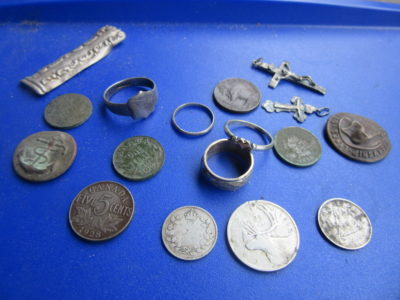Its unbelievable what these new super fast machines like the Equinox and Anfibio Multi can do at the old sites. Anywhere you have old, original ground that’s produced before is worth “having another crack at” with one of these machines. I’ve had good results with both by doing a couple of things:
1/ If I’m searching in a tone ID mode I make sure there’s a big difference between the silver-range tone and the next one down. This helps me to hear those “bleeding” signals that are something in close to iron.
2/ I don’t always run high Gain as a lower setting makes the iron smaller.
3/ I find that most of the time when I dig a spike or big iron its because I forgot to do something–usually involving using the depth meter to see how the signal size and depth correspond. Getting a good initial pinpoint “fix” on a target is the “benchmark” for this.
4/ Some good advice I got a while back was to “listen for which tone dominates.” Watch the ground as you sweep to see if there is a spot where a high meter and tone correspond at.
5/ I also go from a segmented ID mode to a multi tone one to check signals–this gives a little more information on the consistency of something.
6/ I have a sense that these machines will tell you what’s what a lot of the time. There are a lot fewer “one ways” and “degraded” responses with these fast. sophisticated filtering type detectors.

Some recent old stuff including a 1919 dime, and an 1889 Indian Head. at left. Nothing to shake the earth here but these are all from sites I’d given up on years ago.